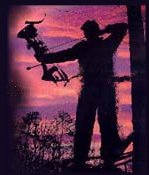|
|
|


You are Visitor #  Since October 14, 2001
Since October 14, 2001
Tracking -
Tracking is an essential part of archery hunting. In order for an arrow to deliver a killing blow it must make a clean incision which will allow the blood to flow freely(inhibits clotting) and allow you to follow the deer to its final resting place. This is one of the main differences between archery and gun hunting for deer. While, the gun delivers a shocking blow which aids in the fatality of the shot, the arrow relies entirely on its blood letting characteristics. A well sharpened broadhead can pass through a deer's vitals and if the deer was not frightened by some noise or scent it may stop and feed. I have actually shot deer that have continued to feed after being shot. In order to follow up a shot on a wounded animal one must ascertain just where the deer was hit. There are several ways you can tell the area where the animal was hit.
1. PAY attention to your shot and note where the shot hit.
2. NOTE THE REACTION of the deer as it was hit.
3. Note the direction the deer travelled after the shot.
4. Go to where the deer was when shot and look for your arrow or
any sign of blood or hair.
Bright red blood indicates an artery hit. Deep red blood indicates a vein hit. Frothy bright red blood tells you it is a lung hit and you won't have far to look. If you find your arrow or note that the blood trail has discolored chunks of meat or can be discerned as digested food you have hit an intestine or the paunch. An animal hit in the paunch/intestines will need a considerable amount of time to expire. You should not consider following that animal for at least an hour, preferably longer. It is essential that you allow the deer to expire before pursuing. A deer with adrenaline pulsing through its veins can travel quite a distance. You MUST be sure to allow the animal to expire in tranquility. Should you jump the deer after it has laid down it will be EXTREMELY hard to track.
A deer that reacts to your shot by hunching up in the middle
before taking flight is usually hit in the paunch. Great care
should be taken in the timing of your tracking efforts. A paunch
shot deer can be retrieved but it takes special care in tracking.
A deer that reacts to the shot by kicking its hind or front legs
has just recieved a shot in the heart/lung area. A heart/lung
shot deer usually does not travel very far. Remember there are
exceptions to every rule and while these reactions are generally
true I must say they do not hold true ALL the
time. different deer react differently.
Once you have decided it is time for you to start
tracking the deer take care to not destroy any of the trail. You
may have to come back and "regroup". I bring a roll of
survey tape with me when hunting for the purpose of marking my
back trail. While you are following the trail note the position
on the ground or vegetation that the blood is found. To determine
from which side the deer is bleeding and how high up the body the
wound is located. Make sure to occassionally mark your trail to
try and get an idea of the direction of travel by the deer. You
may find it necessary to carry a spray bottle of peroxide with
you to determine if a spot is actually blood or just a red spot.
Peroxide will foam when it comes in contact with blood. There is
also a product on the market made specifically for this purpose.
Be meticulous in your pursuit. Do not track in haste. Search all
clues, inspect every leaf and blade of grass if necessary. Should
this not prove to be succesful go to the point of your shot and
make concentric circles around where you shot the deer. Look for
any sign of blood, entrails or tracks which may have been made by
the wounded animal. The MAIN concern is that you should practice
to learn your limits in shooting and be certain to not exceed
them. Lost animals are a fact of hunting and some times can not
be helped. It is our duty as sportsmen to do our utmost to
retrieve ALL game.




My e-mail address:
